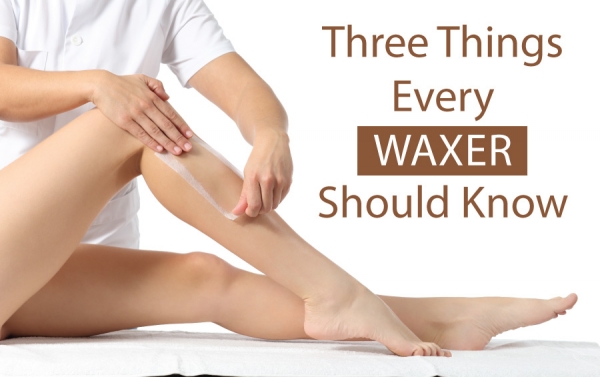At any given point in an individual’s life, a person can experience an increase or decrease in hair growth or gray hair. A savvy service provider will be able to consult on the best hair removal options for smoother, longer-lasting results.
Educate Clientele on Patterns of Hair Loss/Gain
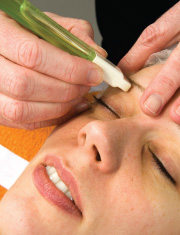 As a waxing salon and laser center, we service the hair removal needs of men and women. The most emotionally driven hair removal clients are women with hormonal imbalances that result in excess terminal hair growth on the face and body. From the client’s perspective, this hair is new and not normal. It is part of a hormonal change that they are experiencing and cannot control.
As a waxing salon and laser center, we service the hair removal needs of men and women. The most emotionally driven hair removal clients are women with hormonal imbalances that result in excess terminal hair growth on the face and body. From the client’s perspective, this hair is new and not normal. It is part of a hormonal change that they are experiencing and cannot control.
Terminal hair growth can occur over the face and body. But the amount of hair displayed is a matter of personal preference. Some clients like to be totally smooth, others shaped or sculpted and some just want to look natural. Terminal hair is also called androgenic hair, because it corresponds to the level of male hormones (androgens) in the body. Women generally experience androgenic hair on the forearms, lower legs and pubic region, while men experience it over the majority of the body. At what point can an individual expect to see some changes in hair growth that do not appear “natural?” Terminal hair begins to develop in prepubescent years with noted changes in the childbearing age and again with menopause symptoms.
Terminal Hair Growth During Childbearing Years
Women are most susceptible to hormone imbalances during their childbearing years (ages 25 to 40) as a result of birth control, pregnancy or general age-related changes within the body. These hormone fluctuations can cause an increase and/or decrease in hair growth patterns. Hirsutism is a condition that characterizes women who grow terminal hair over the face and chest. This pattern of hair growth is triggered by an increase in androgens. Hence, the hair growth pattern is normal for men, but unsightly for women. Most women who display this type hair growth generally suffer from acne, too. The most common causes of hirsutism are polycystic ovarian syndrome and menopause; both conditions should be diagnosed and managed with a gynecologist. Because the condition is internal, hair removal efforts with hirsuite conditions are an ongoing process. Facial hirsutism may be shaved or removed with a cream hard wax. Clients willing to make an investment in permanent hair reduction procedures like laser or electrolysis may end up with neutral results.
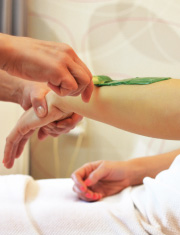 Terminal Hair Growth During Menopausal Years
Terminal Hair Growth During Menopausal Years
On the opposite end of the spectrum, the body’s natural aging process, thyroid disorders, or an iron deficiency may be related to hair loss over the body, on the scalp, and eyebrows. Just because the hair is falling out does not eliminate the need for a hair removal professional. As the hair becomes sparse, giving the client options to enhance their skin or mask the hair loss enhances your professionalism. Coach your client on the best means to fill in the eyebrows for a fuller look and to maintain facial shape. Retailing makeup products that achieve this look is beneficial for your clientele and retail revenue.
Bikini areas that begin to lose hair and look “patchy,” or show signs of gray can make a woman feel like she has lost her youth. Pubic hair may be dyed to cover gray; many of my clientele have opted for Brazilian waxing or laser procedures to simply forget about it. With menopause, estrogen fluctuations may cause the hair to fall out at a more rapid rate and slow hair growth – good news for women who want the hair gone.
Hair Removal Services for Men
Women still make up the majority of hair removal patrons in the spa, but men are gaining in number. It is socially acceptable for men to receive spa services and maintain a more youthful appearance. Men also experience changes in hair patterns as they age and are willing to receive hair removal services that help them look and feel young, but still maintain their masculinity. The pattern of hair growth on the lower back and chest is a genetic characteristic and not an overall concern unless the hair growth is overly “wooly” and/or spreads to the shoulders, upper arm and upper back. Keep the hair pattern on the body masculine and feather the edges so there are no sharp points or shapes. Men want to look masculine, not like Sasquatch. As a man ages, he too begins to experience hair loss, but the primary concern (aside from the hair on his head) is gray hair. One of the most defining characteristics of an “old man” is scraggly long gray hair peeking out the ears and nose, obscuring the eyes and growing on the neck. Every facial that I perform on a man includes an eyebrow, ear, nose, and neck wax. My philosophy: you can drastically improve the look of his skin, but nobody will notice how great his skin looks when he has unsightly gray hair poking out of his nose and ears. To clarify, the waxing I perform is scant. Remove only the hair that peeks out of his nostrils and ears. Never shape his eyebrow, but always be sure he has two eyebrows; keep them from growing into his hairline or eyes and trim any long hair. Give a complete service that improves his overall look while maintaining his masculinity. When people notice his well-groomed appearance and compliment him, it is a reflection of your talent as an aesthetician.
As a man ages, he too begins to experience hair loss, but the primary concern (aside from the hair on his head) is gray hair. One of the most defining characteristics of an “old man” is scraggly long gray hair peeking out the ears and nose, obscuring the eyes and growing on the neck. Every facial that I perform on a man includes an eyebrow, ear, nose, and neck wax. My philosophy: you can drastically improve the look of his skin, but nobody will notice how great his skin looks when he has unsightly gray hair poking out of his nose and ears. To clarify, the waxing I perform is scant. Remove only the hair that peeks out of his nostrils and ears. Never shape his eyebrow, but always be sure he has two eyebrows; keep them from growing into his hairline or eyes and trim any long hair. Give a complete service that improves his overall look while maintaining his masculinity. When people notice his well-groomed appearance and compliment him, it is a reflection of your talent as an aesthetician.
Prevention and Treatment of Ingrown Hairs
Ingrown hairs are unsightly and can be painful if the follicle is infected. Correcting the problem is only achieved by allowing the hair to grow or to trim instead of shave. All traditional means of hair removal, such as shaving, depilatory creams, and waxing can result in ingrown hair so clients who want more permanent options should invest in electrolysis, intense pulsed light (IPL), or laser hair removal.
No matter what type of ingrown hair the client is experiencing, as an aesthetician or wax technician, consulting on the best means to prevent ingrown hair and infection should be a priority. It is a reflection of your quality of care and is an added value to your service.

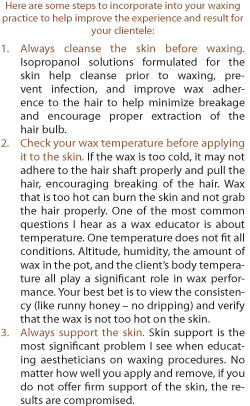 Home Care and Ingrown Hair Prevention
Home Care and Ingrown Hair Prevention
Imagine how perfect our skin and hair would be if pure brainpower could control the follicles. Unfortunately, we cannot control the follicle and rate of hair growth, which is why home care is a significant part of ingrown hair prevention. Encourage three practices at home: cleanse, exfoliate, and hydrate. Together, these three practices help prevent ingrown hair development and infection of the follicle. Aestheticians know that oil, bacteria and dead skin equal pimples. If a follicle becomes infected, the result is pseudofolliculitis barbae (PFB). Cleansing helps control the amount of dirt, oil and infection-causing bacteria on the skin surface. Exfoliating two to three times per week with a manual scrub and/or hydroxy acid complex can prevent cellular buildup that blocks the follicle opening and prevents the hair shaft from exiting to the skin surface. Finally, regular use of a moisturizer that has a high concentration of humectants to help draw in moisture may keep the skin supple and ease growth of the hair out of the follicle. Some examples of humectants include hyaluronic acid, ceramides, glycerin, propylene glycol and butylene glycol. Some ancillary ingredients to help improve the skin after hair removal include tea tree oil to help minimize bacteria, hemp oil to assist with healing and repair, and retinyl palmitate or retinol to promote healthy cell regeneration and desquamation. Together, these healthy skin care practices at home can assist with ingrown hair prevention.
Improving Your Technique to Reduce the Development of Ingrown Hairs
As a hair removal professional, improving your technique, assisting with extraction and retailing products that reduce the number of ingrown hairs is an integral part of a successful practice. Most all aestheticians employ waxing or sugaring to extract the hair from the follicle. More specialized hair removal options like electrolysis, laser, or intense pulsed light help reduce ingrown hair by the process of photoepilation (destroying the follicle). These hair removal options require additional training, certification, and licensing. As a wax technician or aesthetician, your wax temperature, application, and removal all affect the skin and can increase ingrown formation.
Giving an exceptional service is only one-third of the total client care that “go-to” aestheticians and wax technicians offer. The other two values include retailing and extraction services. Clients need to maintain the long-term smooth and flawless results they achieve from waxing. This includes proper cleansing, exfoliation and
hydration. Retail these products to complete the experience, improve your credibility, and gain additional retail revenue. Offer an extraction service for clients who experience painful and unsightly ingrown hairs. Some facilities advertise this service as the “Bikini Facial.” Regardless of the name, maintain a protocol that helps extract the ingrown hairs properly and safely. When done by a professional, there is a decreased risk of infection, post-inflammatory hyperpigmentation, and scar prevention.
Teenage and Tween Waxing Etiquette
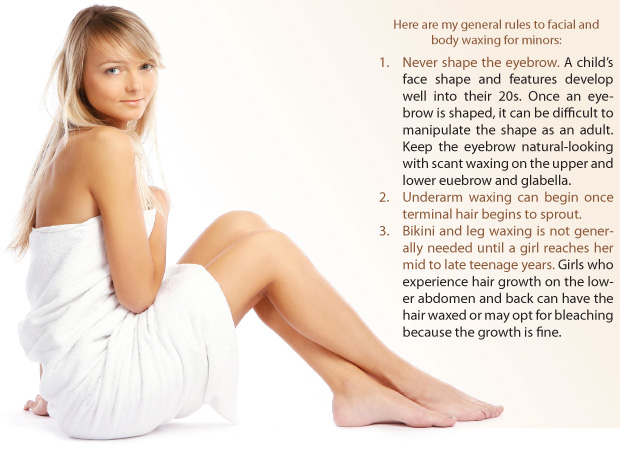 “What did you do to my daughter?” said the most prominent client in the community. It is by far the most memorable waxing story in my spa and one from which all aestheticians can learn. My client’s daughter is a well-traveled, sophisticated young woman. The girl scheduled her regular bikini waxing service with a new aesthetician and during each visit, the girl would request “a little more” hair be removed from her bikini area until she asked for the bare-it-all Brazilian wax. That afternoon, I received a phone call from the girl’s mother, blaring her disapproval into my ear. The technician had no idea that this mature-looking young woman was only 16 years old. This was nearly a decade ago, but it warrants the common question: what age is too young for waxing and what waxing services are inappropriate for children?
“What did you do to my daughter?” said the most prominent client in the community. It is by far the most memorable waxing story in my spa and one from which all aestheticians can learn. My client’s daughter is a well-traveled, sophisticated young woman. The girl scheduled her regular bikini waxing service with a new aesthetician and during each visit, the girl would request “a little more” hair be removed from her bikini area until she asked for the bare-it-all Brazilian wax. That afternoon, I received a phone call from the girl’s mother, blaring her disapproval into my ear. The technician had no idea that this mature-looking young woman was only 16 years old. This was nearly a decade ago, but it warrants the common question: what age is too young for waxing and what waxing services are inappropriate for children?
Girls can display visible hair growth early in life, but androgenic hair may develop as early as eight years of age. As this hair develops, so should a child’s skin care routine with facial treatments and home regimen. Some mothers may want to have their daughter waxing at an early age because the girl is experiencing ridicule from her peers. Boys generally do not begin any type of waxing until they reach young adulthood. I believe that the prepubescent years, age eight or older, is an appropriate time to begin waxing. The parent should always be present to sign a consent form and supervise the service in the room.
Waxing pre- and post-pubescent teenagers is ideal because it helps limit the amount of hair growth over a long period of time and keep the hairs fine. Services like the Brazilian wax or total body waxing to remove fine vellus hair (pigmented or not) for children will require your personal judgment on the matter. There is a level of risk and discomfort associated with waxing that is unique to the recipient. Do you believe a child would ultimately benefit from this service? Do you think a mother would disapprove?
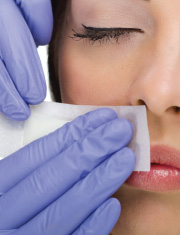 Be the Go-To Spa for Hair Removal
Be the Go-To Spa for Hair Removal
You can be certain that clients want to have long-lasting hair removal results, with minimal discomfort, without downtime and they do not want it to cost too much. They are savvy on procedures and will try several means to achieve their goals, but they also want advice. Aesthetic procedures, hair removal included, require planning and investment. Will you be the “go-to” professional to guide them on the best path and help them achieve their ultimate beauty goals? I encourage each of you to implement your knowledge of the skin and hair and share it with your clients. Encourage them to expand on waxing or to try a new method of hair removal that will best suit their skin and the result they want to achieve. Plan services out over the course of the year and retail the product they should be using to encourage longer, smoother and flawless results. Waxing is a lucrative service in the industry and takes little time. The best part, you can talk with your client as you administer the service because it does not warrant relaxation and ambiance. They will appreciate the distraction. Be a professional who sets a high standard of excellence.
 An entrepreneur in the beauty industry, Tina Zillmann pioneered the physician-aesthetician relationship and began her practice, the Skin Rejuvenation Clinique, under the wing of a plastic surgeon caring for burn victims, assisting in skin grafting procedures and developed the first post-laser skin care system and melanin suppressant system known today as Advanced Rejuvenating Concepts. Her knowledge, talent and desire to educate her peers continues to award her with local and national recognition as a distinguished skin care expert and aesthetic business owner.
An entrepreneur in the beauty industry, Tina Zillmann pioneered the physician-aesthetician relationship and began her practice, the Skin Rejuvenation Clinique, under the wing of a plastic surgeon caring for burn victims, assisting in skin grafting procedures and developed the first post-laser skin care system and melanin suppressant system known today as Advanced Rejuvenating Concepts. Her knowledge, talent and desire to educate her peers continues to award her with local and national recognition as a distinguished skin care expert and aesthetic business owner.
